by Craig Wilson
Originally published in the Arabic-language surrealist journal “The Room”
Urban exploration has been an important part of surrealism since the movement’s early days as you can see in Breton’s Nadja or Aragon’s Paris Peasant. This notion of exploration diverges from the usual activity of ‘going somewhere’ in that the terrain provides the destination by chance and attraction; sometimes moving through a space is seen as a game with certain parameters. Surrealists of every generation have paid attention to what can be found in the city and how we might intervene there. I want to look at several examples of surrealist experience in the city from the modern era.
Some of the Chicago surrealists decorated parking meters to investigate the ‘oneiric perturbability’ of passers-by. As seen in Bulletin of Surrealist Information #4 (1973): “…Robert Green dressed a parking meter on Rush street in Chicago, supplying it with wig, lips, arms, hands, an uplifted led and a rudimentary costume. The pursuit of such experimentation will doubtless unveil much of the erotic and paranoiac sensibilities of the ‘discontinuous’ crowd as its constituents pass from one distraction to another.” Franklin Rosemont’s article The New Argonautica from the City Lights Anthology further explores the notion of wandering and looks at how this intersects with objective chance.

Ody Saban, abandoned seat of Lilith
Surrealist painter Ody Saban has left artwork and objects in public places in numerous different cities. Her abandoned Lilith thrones and tables left in Isle of Brehat, Bologna, Amsterdam and elsewhere provoke curiosity and unsettle the urban environment. The way these odd and impractical chairs and tables were abandoned after their use in performances is both mysterious and amusing.
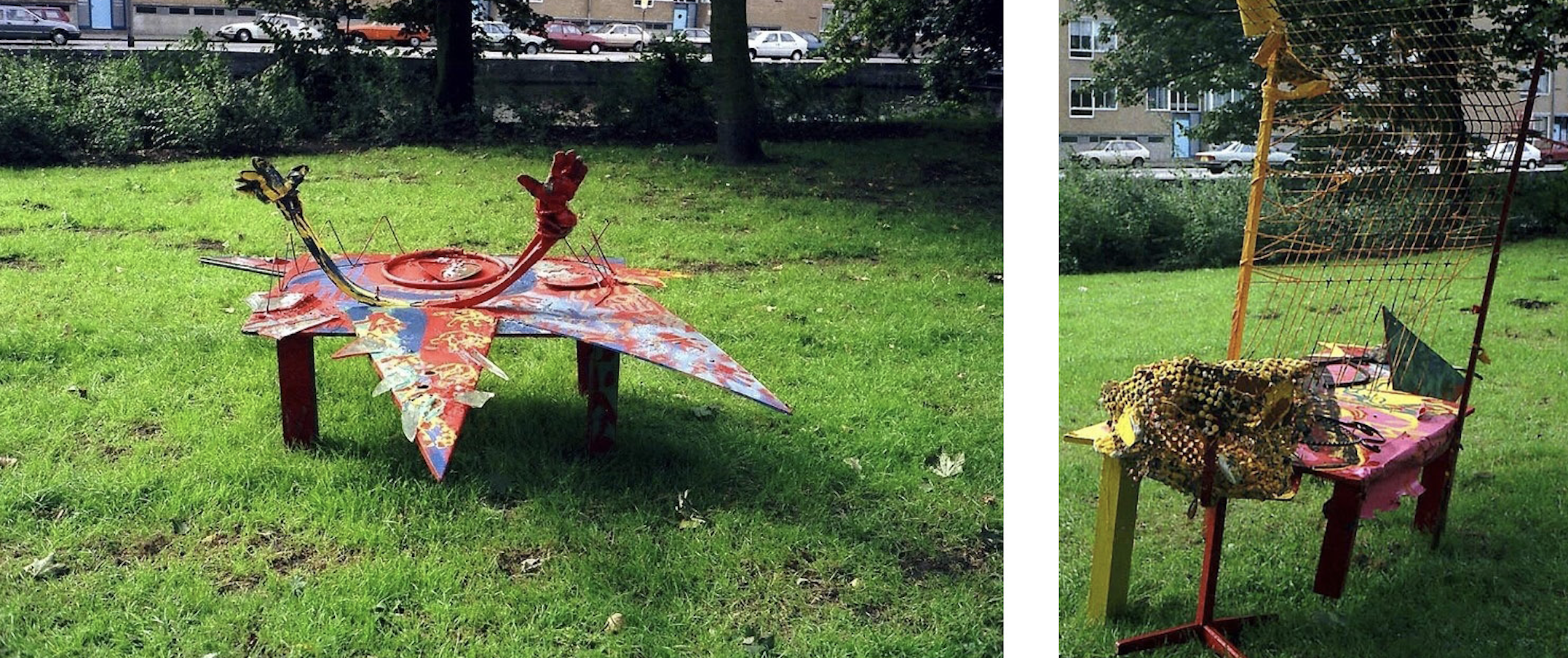
Abandoned Throne of Lilith from Ody Saban
As she recalls “For two days in Amsterdam, the tables and thrones remained in the public garden without moving. On the third day, there were no more sculptures. For the Isle of Brehat, I made my improvisation by the sea. After my performance, the throne was engulfed by the sea, by the high tide.”
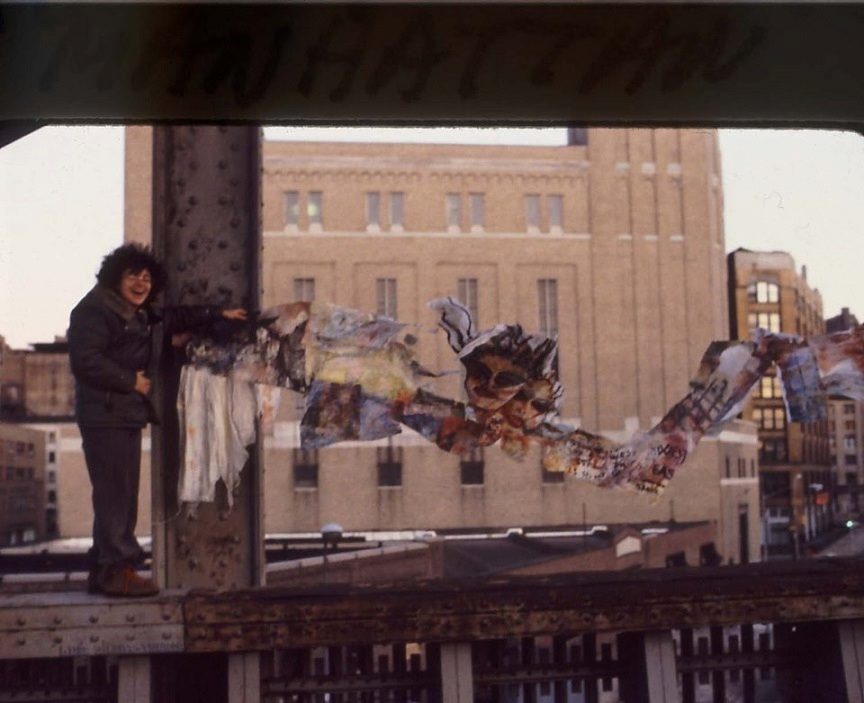
Ody Saban, kite on Manhattan Bridge.
She also left a painted kite on the Brooklyn Bridge in the ‘80s and documented urban adventure in Paris during the ‘90s. She joined Michael Zimbacca and others from the Paris Surrealist Group in the Drift in Paris game. They wrote the names of Paris metro trains, folded each paper and put them in a hat. Each drew a metro name from the hat to determine which subway lines they would take to send them in different directions. For more information see the catalog The Hunt for the Object of Desire from the Liaison Surrealiste exhibition in Montreal, 2014.
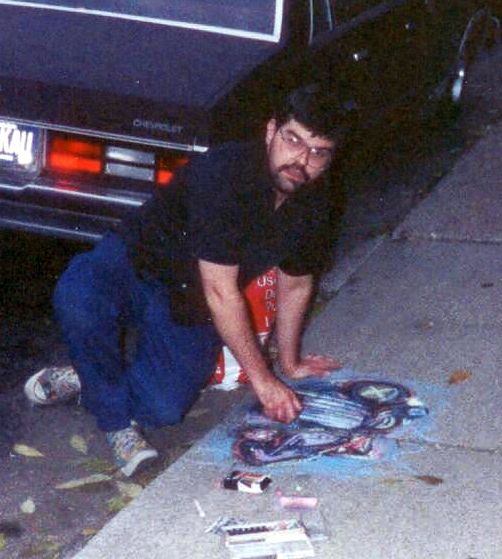
Maurice Greenia, sidewalk chalking, Detroit
Maurice Greenia in Detroit has, since the 1990’s, been making surrealist chalk drawings on public sidewalks and buildings, a practice that can be undertaken at any time and place without risking a vandalism charge. What better way to create sudden surprise than by leaving a colorful scene in chalk under foot where people are often not even looking? That these images can be worn down by footprints or erased by street cleaners or rain only adds to their ephemeral charm. As taggers have known for decades, the utilitarian function of a city building can be subverted by using it as a canvas.
The Surrealist Group in Stockholm, around 1997, described an abandoned, commercially useless area of their city as an ‘atopos.’The plural term would presumably be ‘atopoi.’ Walks were taken under the auspices of poetic materialism. Such documentation included photos of alleys, overgrown patches of concrete, worn and crumbling pavement, and examples of wilderness re-asserting itself in spaces that have slipped away from being financially viable. The term ‘atopos’ has since been adapted by other surrealists to describe these derelict city spaces. Mattias Forshage’s essay on the subject, “Poetry of Worthlessness – Worthless places or Atoposes” appeared alongside another of his works written with Erik Bohman, “Towards the Solidification and Relativisation of Atopos Theory.” These essays explore surrealist urbanism. http://www.surrealistgruppen.org/playground_urbanity.pdf
Old Night Equinox was a 2000’s era surrealist game of hunting for night within the day developed by surrealists in Leeds and in Southampton. Sometime in the afternoon each person was to venture forth in search of night however they chose to define it. This revealed the play of shadows beneath direct sunlight, the atmosphere of abandoned factories and goings-on in city parks, among other things. Results were collected in a Black Book issued by the Surrealist Group in Leeds as well as in unpublished texts from North American surrealists.
Around this same time, during my participation in the Portland Surrealist Group, I carried a tape recorder into downtown Portland, Oregon to ask random people questions about how they would change the city. Interested parties were asked to respond as if they could do anything at all to their surroundings. Responses were sometimes banal and other times quite imaginative and funny; a report appeared on the Flying Stone blog. I found out years later that Jean-Claude Silbermann did a very similar thing with a tape deck in Paris in the 1960s or 1970s.
The London Surrealist Group put out a call for a ‘Mass Derive’ in June of 2006. It involved starting from a point of desire, zone of repulsion or place of chance. One was to follow a series of coordinates (left and right turns) and document what was happening as they moved across the city this way. My Portland walk took me from a shopping mall (zone of repulsion) into nearby streets (zones of attraction), through small shops and eventually onto a bus to continue in a different section of town where I concluded at the sprawling thrift store with an interesting dumpster. Some documentation appears on the London Surrealist Group blog: https://londonsurrealistgroup.wordpress.com
That same year, SLAG (Surrealist London Action Group) started what was for a time an annual tradition-the London International Festival of Surrealism. As Pearl Handel wrote, “Participation in the Festival means, quite simply, conducting as many of the activities as you like, either on your own or with others.” Some games were coordinated and others played at whim over a two week period. There were games using maps from other cities to navigate one’s own city and all manner of other pursuits; there was an abundance of ways to participate. International contributors sent documentation of their activities for a CD-Rom mailed to all participants. See more documentation at https://robberbridegroom.blogspot.com.
In 2008 Oyster Moon Press in Berkeley released The Exteriority Crisis: From the City Limits and Beyond. The editors were Eric Bragg from the U.S., Eugenio Castro from Spain and Bruno Jacobs from Sweden. This book features essays and photos from surrealists in Spain, France, South America and the U.S. about experiences in both the city and more rural areas. It’s obvious from the book’s contents that the surrealists involved had been thinking about the city and about space in general for a long time already. Bruno Jacobs produced a series of bulletins called Anyway: Poetic Materialism that further explored these themes.
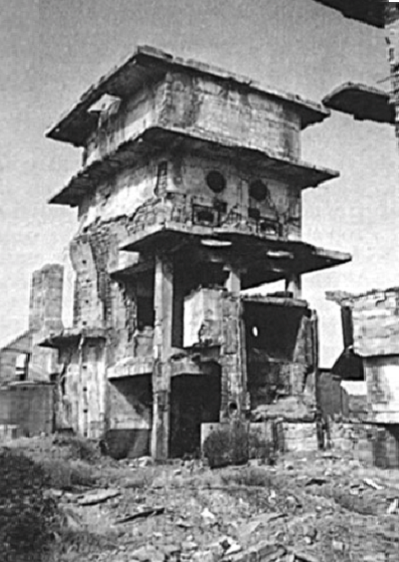
Picture from Miguel Corrales from Anyway: Poetic Materialism 2, 2004
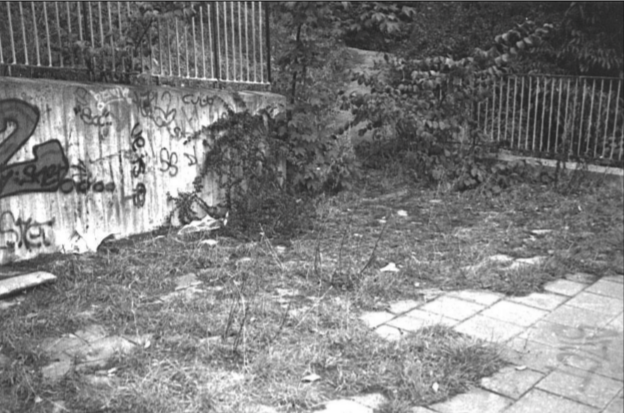
From ANYWAY 1, 2004
Surrealists in Madrid have been intervening in public space since at least the 1990’s; notable actions include affixing shoes to the road, leaving anonymous flyers on utility poles and writing messages in chalk.
In 2013, they sponsored a three-day exhibition of objects in a vacant lot where they held talks and facilitated discussions. The lot was described by a visiting child as being a place where adults played like kids in the park, perfectly summarizing the idea of surrealism as a higher form of play.
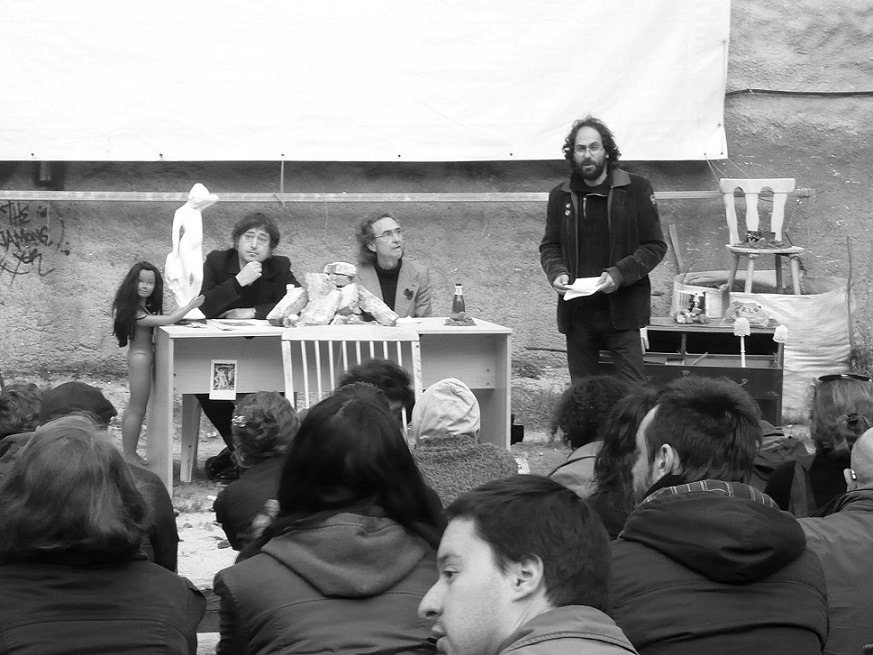
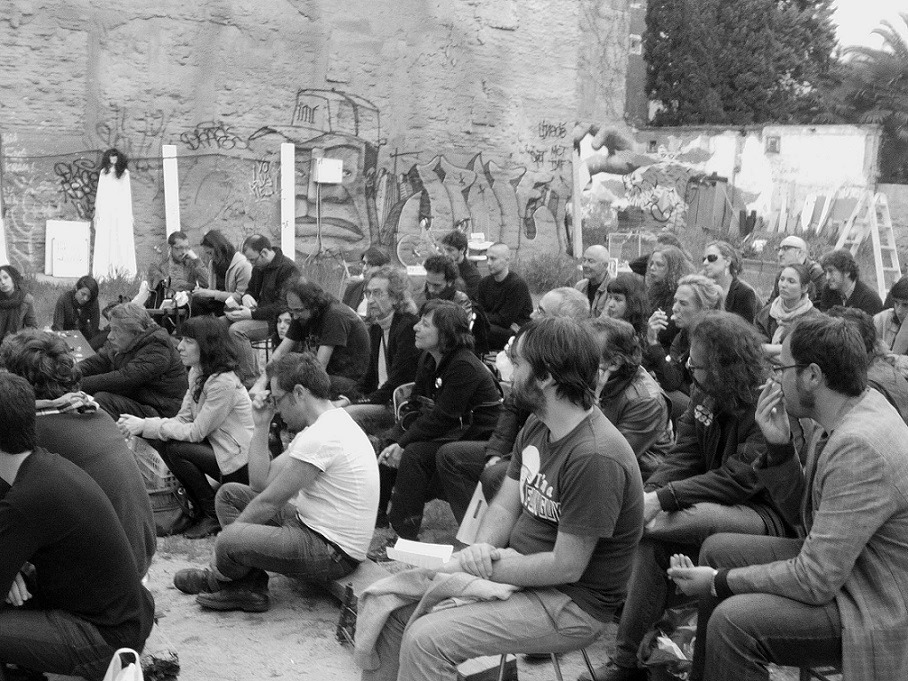
On the third day, objects were constructed by the crowd and hauled away for a night-time shopping cart parade; things were placed at different locations around the city. A group member wrote “It was our responsibility to encourage” a “concentrated space of inspiration…an incantatory vortex…in our hands was the ability to crystallize in the street, in everyday life, for a few days, the theory of the ‘poetics of space’ and its truthfulness.”
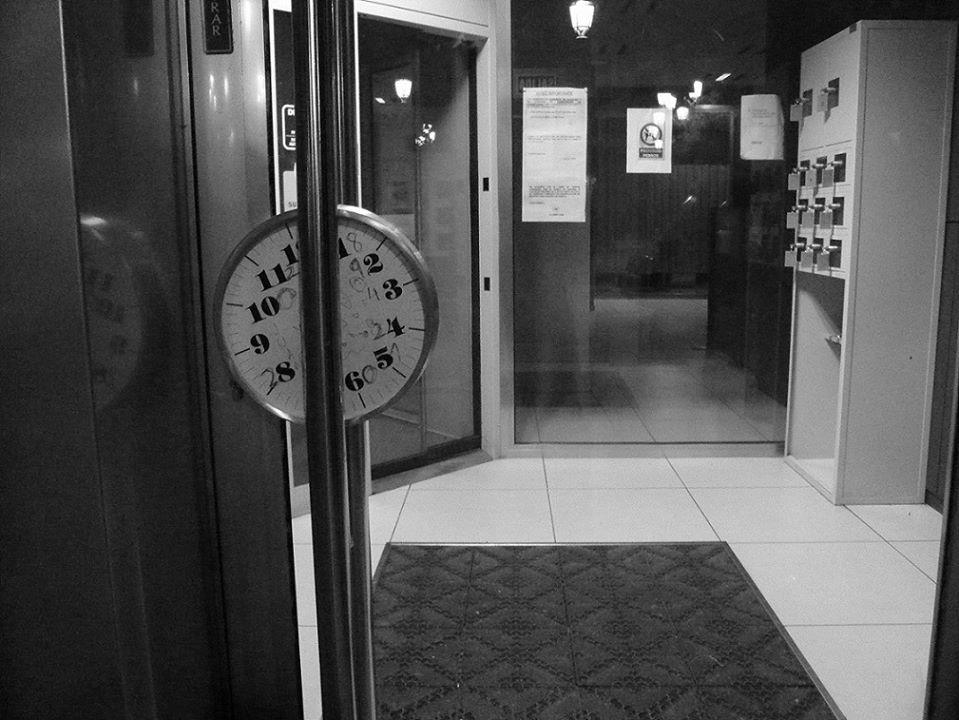

For more information look up Chronicle of the Event About the Object at https://gruposurrealistademadrid.org/.
This article is by no means a complete look at what surrealists have undertaken in this regard. I wanted to document just a few things that illustrate a surrealist attitude towards cities and hopefully suggest new points of departure animated by the same adventurous spirit. Let’s not forget that the recent popular uprisings against repressive governments and capitalist rule are another great example of surrealism in the streets.
